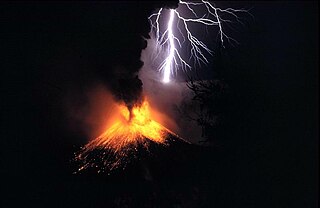Meteorological intelligence is information measured, gathered, compiled, exploited, analyzed and disseminated by meteorologists, climatologists and hydrologists to characterize the current state and/or predict the future state of the atmosphere at a given location and time. Meteorological intelligence is a subset of environmental intelligence and is synonymous with the term weather intelligence.

Information is the resolution of uncertainty; it is that which answers the question of "what an entity is" and is thus that which specifies the nature of that entity, as well as the essentiality of its properties. Information is associated with data and knowledge, as data is meaningful information and represents the values attributed to parameters, and knowledge signifies understanding of an abstract or concrete concept. The existence of information can be uncoupled from an observer, which refers to that which accesses information to discern that which it specifies; information exists beyond an event horizon for example. In the case of knowledge, the information itself requires a cognitive observer to be accessed.

Meteorology is a branch of the atmospheric sciences which includes atmospheric chemistry and atmospheric physics, with a major focus on weather forecasting. The study of meteorology dates back millennia, though significant progress in meteorology did not occur until the 18th century. The 19th century saw modest progress in the field after weather observation networks were formed across broad regions. Prior attempts at prediction of weather depended on historical data. It was not until after the elucidation of the laws of physics and more particularly, the development of the computer, allowing for the automated solution of a great many equations that model the weather, in the latter half of the 20th century that significant breakthroughs in weather forecasting were achieved. An important domain of weather forecasting is marine weather forecasting as it relates to maritime and coastal safety, in which weather effects also include atmospheric interactions with large bodies of water.

Climatology or climate science is the scientific study of climate, scientifically defined as weather conditions averaged over a period of time. This modern field of study is regarded as a branch of the atmospheric sciences and a subfield of physical geography, which is one of the Earth sciences. Climatology now includes aspects of oceanography and biogeochemistry. Basic knowledge of climate can be used within shorter term weather forecasting using analog techniques such as the El Niño–Southern Oscillation (ENSO), the Madden–Julian oscillation (MJO), the North Atlantic oscillation (NAO), the Northern Annular Mode (NAM) which is also known as the Arctic oscillation (AO), the Northern Pacific (NP) Index, the Pacific decadal oscillation (PDO), and the Interdecadal Pacific Oscillation (IPO). Climate models are used for a variety of purposes from study of the dynamics of the weather and climate system to projections of future climate. Weather is known as the condition of the atmosphere over a period of time, while climate has to do with the atmospheric condition over an extended to indefinite period of time.
Contents
The earliest known use of the term "meteorological intelligence" in a written document dates to 1854 on pg. 168 of the Eighth Annual Report of the Board of Regents of the Smithsonian Institution. This report discusses the Smithsonian Institution's initiative to transmit meteorological intelligence via telegraph lines. An early reference to "meteorological intelligence" in England dates an 1866 issue of The Edinburgh Review which was a prominent Scottish journal during the 19th century (Reeve 1866, pg. 75).

The Smithsonian Institution, founded on August 10, 1846 "for the increase and diffusion of knowledge," is a group of museums and research centers administered by the Government of the United States. The institution is named after its founding donor, British scientist James Smithson. Originally organized as the "United States National Museum," that name ceased to exist as an administrative entity in 1967.

Telegraphy is the long-distance transmission of textual messages where the sender uses symbolic codes, known to the recipient, rather than a physical exchange of an object bearing the message. Thus flag semaphore is a method of telegraphy, whereas pigeon post is not. Ancient signalling systems, although sometimes quite extensive and sophisticated as in China, were generally not capable of transmitting arbitrary text messages. Possible messages were fixed and predetermined and such systems are thus not true telegraphs.
The Edinburgh Review has been the title of four distinct intellectual and cultural magazines. The best known, longest-lasting, and most influential of the four was the third, which was published regularly from 1802 to 1929.
Another documented, early use of the term dates to 1874 in a historical compilation entitled, "The American Historical Record" (Lossing 1874, pg. 125). In this book, Lossing uses the term to refer to weather observations transmitted over telegraph lines for the purpose of studying the nature of storms with the ultimate goal of enhancing public safety through the issuance of storm warnings. This mission was carried out by the Army Signal Service starting in the 1870s who was responsible for communication (via telegraph) of technical intelligence for the army as well as "meteorological intelligence" for the general welfare of the country (Ingersoll 1879, pg. 156).

A storm is any disturbed state of an environment or in an astronomical body's atmosphere especially affecting its surface, and strongly implying severe weather. It may be marked by significant disruptions to normal conditions such as strong wind, tornadoes, hail, thunder and lightning, heavy precipitation, heavy freezing rain, strong winds, or wind transporting some substance through the atmosphere as in a dust storm, blizzard, sandstorm, etc.

The United States Army Signal Corps (USASC) is a division of the Department of the Army that creates and manages communications and information systems for the command and control of combined arms forces. It was established in 1860, the brainchild of Major Albert J. Myer, and had an important role in the American Civil War. Over its history, it had the initial responsibility for portfolios and new technologies that were eventually transferred to other U.S. government entities. Such responsibilities included military intelligence, weather forecasting, and aviation.
From the viewpoint of the intelligence community, the term meteorological intelligence is more limited in its use referring to the use of clandestine or technical means to learn about environmental conditions over enemy territory (Shulsky and Schmitt 2002) as in the North Atlantic weather war. In the military intelligence context, weather information is often referred to as meteorological or environmental intelligence (Hinsley 1990, pg. 420; Platt 1957, pg. 14; U.S. Congress, pg. 164).
A clandestine operation is an intelligence or military operation carried out in such a way that the operation goes unnoticed by the general population or specific enemy forces.

The North Atlantic weather war occurred during World War II. The Allies and Germany tried to gain a monopoly on weather data in the North Atlantic and Arctic Oceans. Meteorological intelligence was important as it affected military planning and the routing of ships and convoys. In some circumstances, visibility was necessary and in others concealment. D-day planning was greatly affected by weather forecasting; it was delayed by one day in the expectation that a storm would blow out and sea conditions would be acceptable. British sources of data included ships at sea and the weather stations at Valentia Observatory and Blacksod Point, in neutral Ireland; German use of weather ships also exposed their secret Enigma codes.
Military intelligence is a military discipline that uses information collection and analysis approaches to provide guidance and direction to assist commanders in their decisions. This aim is achieved by providing an assessment of data from a range of sources, directed towards the commanders' mission requirements or responding to questions as part of operational or campaign planning. To provide an analysis, the commander's information requirements are first identified, which are then incorporated into intelligence collection, analysis, and dissemination.
With regard to private sector meteorology, the term meteorological intelligence is a broad term of art that is primarily associated with observed and forecast weather information provided to decision makers in one of a number of weather sensitive business areas including: Energy, forestry, agriculture, telecommunications, transportation, aviation, entertainment, retail and construction (CMOS 2001, pg. 23) . It is considered a key aspect of weather risk management for the legal and insurance industries.

Forestry is the science and craft of creating, managing, using, conserving, and repairing forests, woodlands, and associated resources for human and environmental benefits. Forestry is practiced in plantations and natural stands. The science of forestry has elements that belong to the biological, physical, social, political and managerial sciences.

Agriculture is the science and art of cultivating plants and livestock. Agriculture was the key development in the rise of sedentary human civilization, whereby farming of domesticated species created food surpluses that enabled people to live in cities. The history of agriculture began thousands of years ago. After gathering wild grains beginning at least 105,000 years ago, nascent farmers began to plant them around 11,500 years ago. Pigs, sheep and cattle were domesticated over 10,000 years ago. Plants were independently cultivated in at least 11 regions of the world. Industrial agriculture based on large-scale monoculture in the twentieth century came to dominate agricultural output, though about 2 billion people still depended on subsistence agriculture into the twenty-first.

Telecommunication is the transmission of signs, signals, messages, words, writings, images and sounds or information of any nature by wire, radio, optical or other electromagnetic systems. Telecommunication occurs when the exchange of information between communication participants includes the use of technology. It is transmitted either electrically over physical media, such as cables, or via electromagnetic radiation. Such transmission paths are often divided into communication channels which afford the advantages of multiplexing. Since the Latin term communicatio is considered the social process of information exchange, the term telecommunications is often used in its plural form because it involves many different technologies.










